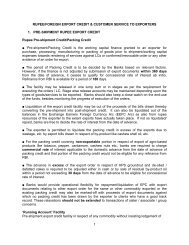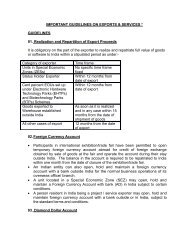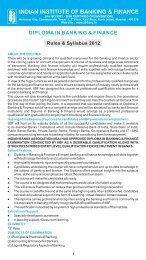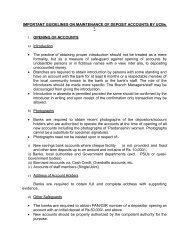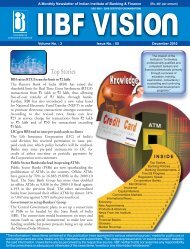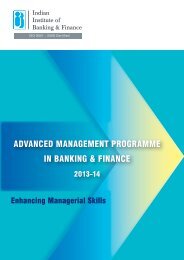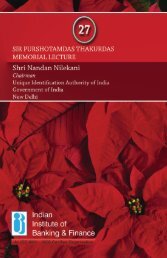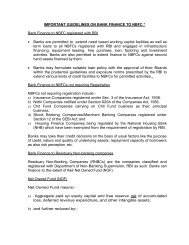You also want an ePaper? Increase the reach of your titles
YUMPU automatically turns print PDFs into web optimized ePapers that Google loves.
special featureAs the target of having a physical banking facilityin every habitation is unrealistic, the inclusion strategyis largely based on the use of Information andCommunication Technology (ICT), expansion of bankingaccess virtually through the mechanism of a BusinessCorrespondent (BC), opening of off-site ATMs, andproviding mobile banking. As indicated in the MonetaryPolicy Statement, 2011-12, of the Reserve Bank, bankscovered 24,066 villages with population above 2000 and19,271 villages with population less than 2000. It hasbeen reported in the Economic Times (June 13, 2011)that deeper banking spread has become urgent becausegovernment plans to provide direct cash subsidy forfertilizer and kerosene to 40 crore poor from March 2012.Section-IIIMicro finance- concept and developmentThe term microfinance denotes small scale financialservices - both credit and savings - that are extendedto the poor people of the society. Micro Finance(Development & Regulation) Bill, 2010 defines microcredit not to exceed `50,000 per borrower. According toProf. Sriram, microfinance in India started in the early1980s in forming formal self-help group (SHG) and hadgrown rapidly in the last two decades. The movementstarted in participation of informal sector, particularly byNGOs. The movement entered the second phase in1992 with participation of formal sector like commercialbanks, co-operative banks and Regional Rural Banks.Thus, 1992 can be termed as turning point in the historyof microfinance movement in India.Self / Help Group - Bank Linkage Program (SBLP)Reserve Bank of India through NABARD, introduced apilot project in 1992, for purveying micro credit to therural poor by linking Self Help Groups (SHG) withcommercial banks, co-operative banks and RegionalRural banks. Since then it has made rapid strides. TheSHG-bank linkage model of micro credit has evolvedas an effective and successful model to extend creditto poor. RBI issued comprehensive guidelines tobanks in February 2000 for mainstreaming microcredit and augmenting the outreach of micro creditproviders. These guidelines stipulated that micro creditextended by banks to individual borrowers directly orthrough a financial intermediary would be reckoned aspriority sector lending.There is an exponential growth of SBLP as may begauged from the following table :March-end No. of SHGs Bank loans {Cumulativefinanced by banks disbursement} (` crore)1999 32,995 572000 114,775 1932001 263,825 4812002 461,478 1,0262003 717,360 2,0492009 1,610,000 12,2542010 1,590,000 14,453Source : Report on Trend and Progress of Banking in India,Reserve Bank of IndiaJoint Liability Groups approachA Joint Liability Group (JLG) is an informal groupcomprising of 4 to 10 individuals for the purposes ofavailing bank loan either singly or through the groupmechanism against mutual guarantee. JLG performsthe function of screening high-risk borrowers fromthe pool of loan applicants. Groups are formed onthe basis of self-selection by borrowers who live in thesame community, and who are well acquainted witheach other. A person regarded as a high-risk borrowerby others will not be included in a group since he is morelikely to default and would cast a financial burden on therest. Besides excluding bad borrowers, group formationencourages "peer-monitoring" activities.Lessons from international experienceBangladesh is a prime mover in microfinance. TheBangladesh Grameen Bank model is pioneer forfinancing the poor and downtrodden. The micro financeprogram in Bangladesh is widely studied and accepted.Today, the idea of small, collateral-free loans for poorwomen known as 'microcredit' or 'microfinance' hasbecome a commonplace around the world. According toNobel Laureate Mohammed Yunus, micro finance is aform of social business that can eradicate poverty. “ Youcan provide micro credit to poor people so they cancreate their jobs through self-employment”. Professor54October - December 2011The Journal of Indian Institute of Banking & Finance



